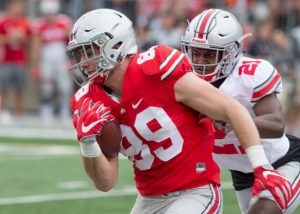TE Depth May Add New Dynamic To Ohio State’s Offense

The level of involvement for Ohio State’s tight end unit is an annual conversation that rarely leads to production on the field, but it appears the Buckeyes may finally feature the position as something more than an extension of the offensive line that occasionally catches a pass.
Senior Rashod Berry (4 starts); juniors Luke Farrell (10 starts) and Jake Hausmann; and sophomore Jeremy Ruckert all return for another season, which gives first-year head coach Ryan Day, offensive coordinator/tight ends coach Kevin Wilson and new co-offensive coordinator/passing game coordinator Mike Yurcich plenty of depth and versatility at the position.
“With those four guys, we’ve been playing them all,” Wilson said. “They can all flex out. They’re all strong enough now to come inside. We’re playing sometimes two of them on the field a lot. In our day and age of tight end, we’re looking for receiving type players who became tough enough and big enough to block.”
It’s been 16 years since Ohio State had a single tight end record more than 30 receptions in one season, as Ben Hartsock hauled in 33 catches for 209 yards and two touchdowns for the Buckeyes in 2003. But if winter workouts — during which the tight ends were named the Unit of the Offseason — and spring football were any indication, that streak could end this fall.
“(Farrell) is a really good player,” Wilson said. “He’s worked very, very hard. He cares a lot. He’s more talented than people think. He’s very, very steady. Not flashy. He’s been our most consistent player. I think Rashod is our strongest and most dynamic player. And then Ruckert has the most upside. Jake had a slight little tweak, but he’s been doing well.”
The Buckeyes, who will also add Cormontae Hamilton — a three-star prospect from Memphis, Tennessee — in the fall, spent a considerable amount of time this spring with two tight ends on the field. And faced with a significant loss of production at the wide receiver position, the staff will likely lean on the experienced tight end unit now more than ever.
“To me, the fun part is when you can put guys on the field and they can do multiple jobs and the defense doesn’t know what’s going on,” Wilson said. “If you have to substitute and you put a big guy out there and they just run the ball and then you have to substitute, after a while, they go, ‘Hey, the passing tight end is in,’ or the big running back is in, so it’s an inside run.
“(In the past), the second tight end was never as good as the second receiver or the third receiver or the fourth receiver. So what you’re gonna do is play your best 11, 12, 13, 14 or 15 people. But if the tight end position is better and their skill set says they can do a lot of different jobs, now you change formations and get them on the field.”
[divider line_type=”Full Width Line” line_thickness=”2″ divider_color=”default”][nectar_btn size=”jumbo” button_style=”regular” button_color_2=”Accent-Color” icon_family=”none” url=”http://www.buckeyesports.com/boards/” text=”Join The Conversation”]